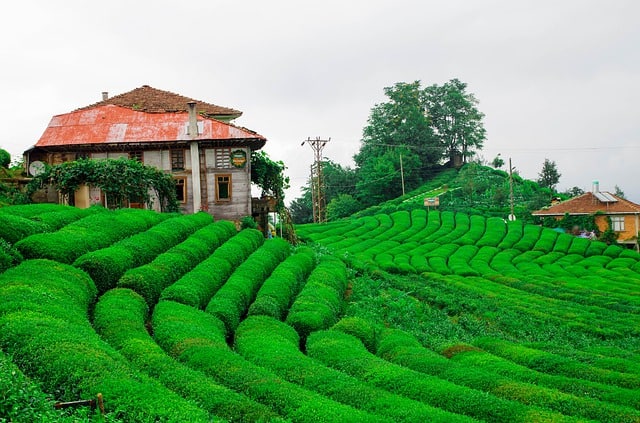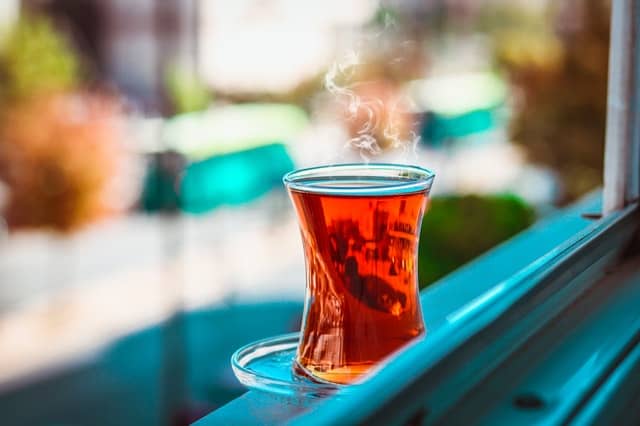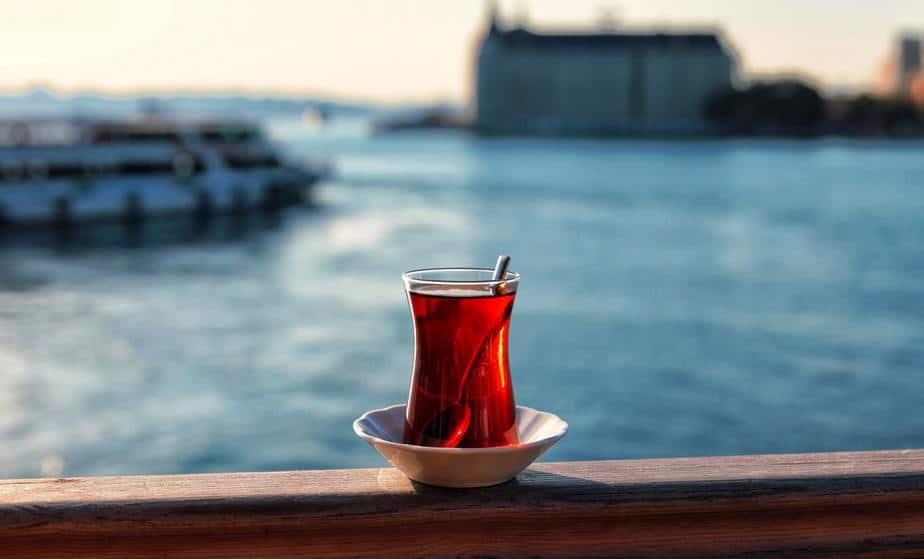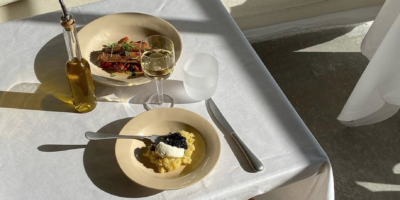Turkish Tea Culture: Brew the Perfect Turkish Black Tea!
It is difficult to imagine Turkey and Turkish hospitality without its hot mahogany coloured black tea, with a hint of dried bergamot. Tea drinking is an integral part of the fabric of society in Turkey and all kinds of events, celebrations and even funerals. Turkish tea is wrapped up in traditions tied in with Turkish society’s hospitality. There’s a famous folk saying from Sivas that captures the importance of tea in Turkish society (from the Turkish Cultural Foundation):
“Caysiz sohbet, aysiz gok yuzu gibidir”
“Conversations without tea are like a night sky without the moon”
When one thinks of Turkish tea, drinking it out of European style, delicate tea cups is out of the question. It is best enjoyed in a Turkish tea cup and saucer!

Tea making in a unpretentious country teahouse in Kümbet Highland in Dereli – Giresun, Turkey. Photo sourced from Wikimedia Commons
Turkish Tea Production
In Turkey, the whole Black Sea coast is known for its tea farms and plantations. The region’s mild, wet climate and mountainous landscape became the perfect place for tea plantations. The region produces almost all of Turkey’s tea that’s consumed entirely by its population. You’ll also find some traditional and country-style teapots and tea making in this region of Turkish highlands. For instance, in cities and small villages of the Black Sea coast, tea production and consumption is the highest, such as Giresun or Rize, the city that’s known as the Tea Capital of Country! If you ever want to take a trip to Rize, that’s possible as the tea plantations do allow a way to take a tour around.
In fact, Turks drink one of the highest amounts of tea in the world! According to the Turkish Cultural Foundation, that’s averaging about 1,000 cups per year. This is probably due to the availability of tea, its strong connection to social norms and traditions, and of course, the domestic production along Black Sea.

Tea Plantation in Rize, Turkey. Image by yusuf kazancı from Pixabay
Turkey is considered the world’s sixth largest producer of tea after India, China, Kenya, Sri Lanka, and Indonesia. The Black Sea coast’s tea production stretches from the border with Trans-Caucasian country Georgia, to the town of Rize and even further towards Trabzon and Karabük, not far from Istanbul. Many families are involved in the production of tea and there are many brands and companies operating in this region.
The Camellia Sinensis plant produces all the kinds of tea we know: black, or green or in between. It’s the fermentation process that determines what the tea will become. Non-fermented tea becomes green, while black tea is fermented in an oxidization process. In Turkey, it is believed that the tea produces uses no chemicals or additives and that makes it organic unlike other countries.
Turkish Tea Culture
Turkish tea is usually enjoyed leisurely — over breakfast, over a hour-long meetings or in the evenings with family and friends. Moreover, only one glass of tea is usually not enough for these situations. Turks often want seconds, thirds and even more and the occasion doesn’t matter – tea is an integral part of the culture and life in the country.
Take a trip to any city, town or village in Turkey and you are sure to find a tea garden, usually overlooking a beautiful view or scenery. Tea houses, called Çayevi, around the country are lively, social places in almost every neighbourhood, where people drink away their worries, play games and even discuss politics. These places are preferred way that people interact, exchange news and even gossip!

Photo by Hasan Albari from Pexels
A Turkish tea garden or tea houses are loud, social places unlike their Japanese counterparts. They are not quiet or serene, but rather hubs of social activity and often with children running around, young and old. Large cities and touristic places often do welcome foreigners as well. Perhaps, one can say that tea gardens in Turkey is probably the one place where you can find people of all strata and status.
Take a trip to Pierre Loti, for instance, one of the best known places for a cuppa. If you prefer to drink like a local, head to Moda tea garden. Check out our article on places to go and see in The Top 10 Things to do in Istanbul’s Asian side to learn more about this side of town.
If and when you visit Turkey, make sure to pop into a local supermarket to grab a good brand such as Çaykur or Dogus to buy some tea as a souvenir to take home! Grab a few different types of the country’s black tea including some herbals ones.
Turkish Teapot
A double teapot is the teapot of choice in Turkey. It’s called a Çaydanlik and resembles a Russian samovar but it much lighter and more portable. A bigger kettle at the bottom heats the water and loose leaf black tea is added on top in what’s called a Demlik. When the water is heated, it is added in the top part and allowed to sit, while the bottom is again filled with water. It is then left to boil over the heat, which can then to enjoyed again. It is customary for the host to ask you if you’d like a second serving if they see your glass empty.
The mahogany coloured tea is prepared in these tea pots and brewed for at least 15 minute. It is thoroughly infused before being served in its own unique way. The concentrated tea from the demlik is diluted with plain boiling water from the lower kettle.
There are a variety of them available depending on your preference and needs: stainless steel, glass, durable plastic, aluminum, copper and enamelled metal. Traditionally these types of double teapots were made of brass or copper, and for the aristocracy in gold and silver too.
Today, it’s impossible to imagine a Turkish household without at least one! Modern ones come with voice-activated features that tells you when the tea is ready. Recent years have been a rise in the use of porcelain teapots. But the tea is again, allowed to sit for more than a few minutes. This is unlike English tea which is brewed for only 3-5 minutes at most.
Turkish samovars are popular souvenirs among tourists who’d like to take them back from their travels.
Turkish Tea Cups
Turkish tea is best enjoyed in its own unique glass: a thin-waist tulip-shaped glass. Known as ince belli, these cute teacups are accompanied by small decorated saucers and typically served with cubes of white sugar.
The preference for these clear glasses is because you can admire the colour of the tea.
Tea Brewing Methods & Variations
Learning how to make a particular tea in a particular country is a wonderful way to deep dive into one beautiful culinary and cultural history lesson. Turkish tea is no exception as there’s a standard way of preparing and serving the drink. Let’s learn more about what tea drinking in Turkey comprises of.
The country’s tea preparation of choice embodies a hybrid way to create something distinctly Turkish. The double tea pot resembles the samovar from Russia, the preference for loose leaf tea closely resembles the ones in China and beyond.
Tea in Turkey is processed using an oxidization method, borrowed from China. However, the preparation method is borrowed from Russia. That is, it needs hot boiling water to completely infuse and release its flavour. Pure, filtered drinking water is the water of choice instead of tap water, free of minerals. A porcelain teapot is preferred sometimes over a steel or aluminum tea pot. Whatever your preference, make sure the tea is fresh, the water is pure and that you set aside time to brew your perfect pot!

Photo by Musa Ortaç from Pexels
How To Make Turkish Tea In Turkish Tea Pot
It’s quite easy to brew Turkish tea in the following few steps:
- Pour water in the large teapot and let it boil on medium high heat.
- Add the tea leaves in the smaller tea pot and add half the boiled water from the bottom pot.
- Fill the large tea pot with more water and let it boil.
- Reduce the heat and let the double kettle simmer so that the heat reaches the tea leaves in the small tea pot.
- Let the tea pots simmer for 10-15 minutes and sit for a while so the leaves infuse and sink to the bottom.
- Once the 15 minutes are up, pour the tea and enjoy.
- You can choose to leave the tea pot on, on the lowest heat, so if you want seconds, you don’t have to reheat the pot again.
- Enjoy your tea within 30 minutes because after that the tea is too bitter and doesn’t taste the same!
Let’s make that more clear: First, the infused tea is poured and then topped with hot water. This way, the tea can then be drank strong, mildly strong, or weak depending on what the drinker wants. Add more or less water depending on preference and taste.
For a stronger brew, you can have it dark called koyu or a lighter one called açik. However, majority of people prefer a colour between the two, similar to rabbit’s blood (tavşan kani). It’s certainly different than the tea bag method of tea brewing. Lastly, milk with tea is never offered but sugar cubes and sometimes lemon are served.
Things to Keep in Mind
The best time to drink Turkish tea is anytime, anywhere and always!
Don’t burn the small tea pot with leaves by placing it directly on the stove. This will spoil both the taste and the look of the tea. Turkish tea needs more time and follow up — this is not a quick ready in 5 minutes tea!
The tea in the smaller pot is heated from the bottom through steam in the large tea pot. So do take your time! Moreover, make sure not to over boil the water as it can burn the leaves and release too much caffeine. This can make the brew too bitter and a waste of time and effort.
In Turkey, while tea bags are now available, they don’t have the same flavor as the tea leaves. Tea bags don’t give us the same taste and of course, don’t give us the same taste as the tea leaves. To enjoy a great glass of Turkish black tea, make sure to have a double tea pot or at least two different kettles that can be stacked up to get the same taste.
Offer Turkish tea in its own unique way to your guests – a strong brew(koyu) or light (açik) or a mahogany-red or the colour of rabbit’s blood (tavşan kani).
Like any loose leaf tea, make sure to store it in a tight container to preserve its freshness.
Did You Know?: Turkish Tea Brewing Competitions
These steps are quite important, so much so, almost every year the Rize Trade Bureau holds a tea brewing competition.

Photo by Kübra Doğu from Pexels
In 2017, a woman named Aytül Turan won this competition using an interesting method. She used pure snow from the mountains to make her most delicious tea and used the melted water to brew her tea and win. She first boiled the water and then added the black tea and let it rest for 20 minutes. Usually, the water and tea are boiled together and then served either dark or light, as mentioned above.
The suggestion by the winner is to add the water first and then the tea. This way, her delicious steeped tea won the competition that year! As you can imagine, in order to brew tea with snow water, you first need to find unpolluted, pure snow.
The following year in 2018, competition winner Gülhanım Delihasan suggests making Turkish tea in a copper or porcelain pot! Try it it this way, with snow and in a porcelain teapot and let us know how delicious your tea was!
Obviously, it makes sense to use the best ingredients and since water is a major component of tea, it makes sense that pure and clean water, with less minerals, for instance, does impact the taste of the tea!
Planning a trip to Paris ? Get ready !
These are Amazon’s best-selling travel products that you may need for coming to Paris.
Bookstore
- The best travel book : Rick Steves – Paris 2023 – Learn more here
- Fodor’s Paris 2024 – Learn more here
Travel Gear
- Venture Pal Lightweight Backpack – Learn more here
- Samsonite Winfield 2 28″ Luggage – Learn more here
- Swig Savvy’s Stainless Steel Insulated Water Bottle – Learn more here
Check Amazon’s best-seller list for the most popular travel accessories. We sometimes read this list just to find out what new travel products people are buying.










